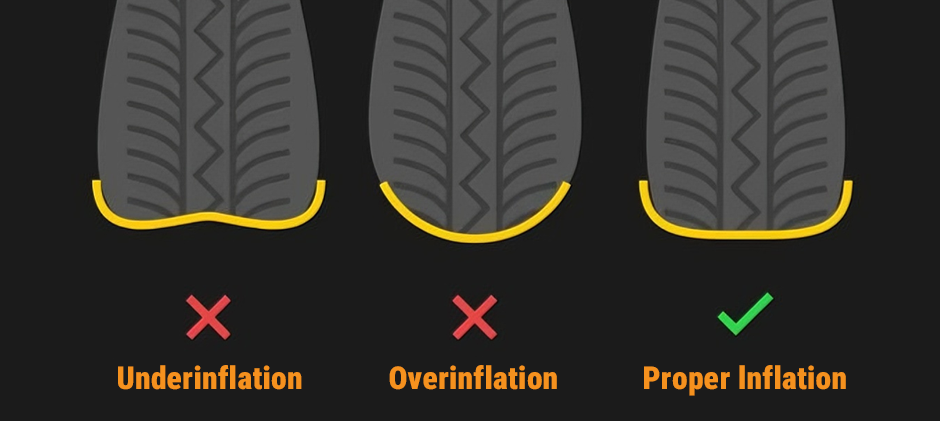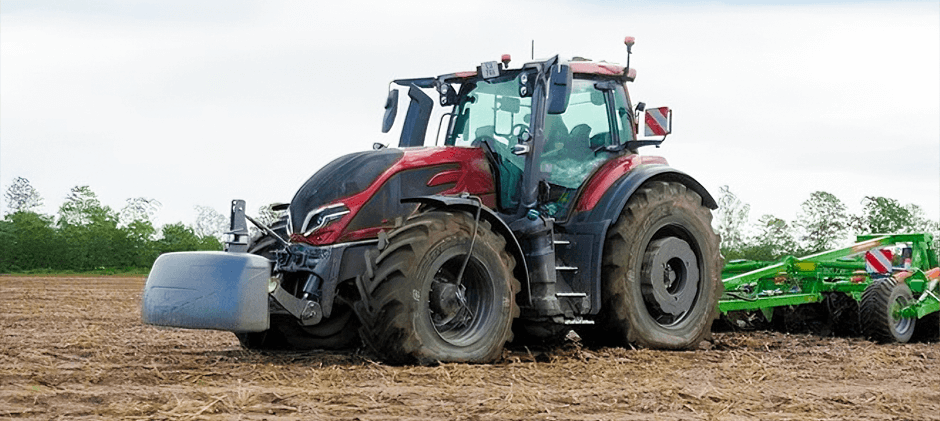Tire pressure is related to your machine’s performance, like traction, fuel efficiency, stability, and even the tires’ service life. So, keeping pressure in the proper range is important. It is better to follow the manufacturer’s recommendations. But sometimes, you might have to keep working even if the pressure drops a bit. In those emergencies, how low is too low for tire pressure?
What Pressure Is Too Low For Safe Operating?
Heavy equipment isn’t like a regular car—no one standard’s “too low” for every machine. The real answer is way more important: if the pressure drops way below what the manufacturer recommends—considering how much weight you’re carrying and what you’re using the machine for—that’s too low.
There is a simple and easy-to-remember experience: if the pressure is 20% to 25% lower than the pressure recommended by the manufacturer, it is too low and dangerous! As an example, a tire with a rated air pressure of 80 PSI is basically causing trouble for itself if it only has 60~65 PSI. Don’t be fooled by the appearance. Even if the tire doesn’t look flat, its internal structure has actually been crushed.
Heavy machinery is so heavy that it can hide how underinflated a tire really is. A loader or excavator tire can lose a quarter of its pressure, and you’d still think it looks normal just by looking at it.

What Is The Recommended Tire Pressure?
If you want to avoid risks, you must first know what the correct target air pressure of your machine and tires is. This value is not a fixed “one-size-fits-all” standard. It will vary with the type of equipment, tire model, and operating conditions. The following methods can help you find accurate data:
- Operation Manual: Please look carefully at the operation manual provided by the manufacturer. The above will explain how much gas the tire needs to be charged under different loads and operating conditions.
- Machine’s Data Plate: View the decal or plate inside the cab or on the body chassis. This has the tire size and recommended air pressure on it.
- Tyre Manufacturer Information: If you have replaced a non-original tire, go check the tire brand’s manual or official website. The instructions say the air pressure range.
Note, wait until the tire cools, then check and adjust the tire pressure. The tire temperature is very high just after the machine stops, and the tire pressure will naturally rise. Neither deflation nor inflation is accurate at this point. It’s better to wait a few hours before checking.
Why Should You Avoid Operating With Low Tire Pressure?
Running on low-pressure tires hurts equipment performance and risks job site safety.
Blowouts
This is one of the most dangerous situations. When the air pressure is too low, the tire sidewall is pressed to and fro, especially with the kind of large, thick, heavy equipment tire, and this repeated bending generates a lot of heat. Once the rubber and internal cords are too hot, they can burst open. If a loader or dump truck tire weighing several tons explodes at such a time, the machine may lose control, drop, or even overturn, with serious consequences.
Increased Operating Costs
Too low tire pressure can make fuel consumption high. The lower the tire pressure, the greater the rolling resistance. Simply, if it is not enough, the engine will push the machine harder, and the oil will naturally burn more.
Drastically Shorter Tire Life
When the tire pressure is too low, the force is uneven and the pressure squeezes to the outside of the tire. The result is that the tread is ground quickly and unevenly, and the lifespan may be directly reduced by half.
At the same time, the high temperature and stress inside the tire can also break the carcass. It’s only possible to get a new tire in advance, which costs more.
Damage to Machine Components
The problem isn’t just with the tires. When the air pressure is too low, the cushioning effect of the tire will become worse. All kinds of shocks and jolts are transmitted directly to the wheels, axles and suspensions. Over time, these parts are stressful, fast to grind, and prone to problems.
Compromised Traction
When the tire pressure is too low, the tread will be pressed to deform more severely and wear faster, and the grip will naturally be poor. This problem is even more obvious on soft ground, mud, or when it rains or snows. The machine is prone to slipping, deviation, or even loss of grip, which is quite dangerous. Moreover, as soon as the weather gets cold, the air pressure will also drop, so in winter or when working in a cold environment, pay more attention to the tire pressure and don’t let it get too low to keep the equipment stable.

What Affects Your Machine’s Tire Pressure?
Tire pressure is not static but a dynamic variable influenced by several factors. Understanding these factors is key to effective maintenance.
- Ambient Temperature: This is the biggest external factor. Generally, pressure varies by about 1-2 PSI for every 5.6°C (10°F) change in air temperature. Even if there is no air leakage, a machine parked overnight in cold weather may show low air pressure in the morning.
- Operational Heat Buildup: The friction from rolling and bending under heavy loads generates a lot of heat, which causes the internal pressure of the tyre to rise by 15% or more over one working shift. This is normal, so setting the correct cold tire inflation pressure is critical.
- Slow Leaks: Unlike a sudden puncture, slow air leakage may not be noticeable. They are usually caused by valve failure, crumbs stuck between the bead and rim, or tiny punctures from nails or steel bars that have not yet caused a puncture.
- Site Hazards and Punctures: sharp objects dot construction sites, mines, and agricultural sites. Rocks, scrap metal and other debris pose a constant threat and are a major cause of sudden tire depressurization.
- Heavy Loads: The air pressure inside the tire supports the load. Although it is not necessary to adjust it every time the material is loaded and unloaded, it is recommended that the tire pressure be calculated according to the maximum load rating of the machine. Persistent overloading can also cause stress on the tire, even if it is inflated normally.
Tire Pressure Maintenance Tips
If you want to keep your tires in a safe and efficient state at all times, active maintenance is the key. Incorporate these simple habits into your daily routine.
- Check the pressure: Don’t ignore this step. Treat “testing pressure” as part of daily inspections. Remember to use a good tire pressure gauge with high PSI specifically for heavy equipment.
- Use a pressure gauge: Never look at a tire with your eyes. Even if a heavy-duty tire runs out of air, it may look like nothing has changed. So you have to use a tire pressure gauge every time. Don’t rely on feeling.
- Inspect the entire tire system: When measuring the air pressure, check to see if the tire has been cut, stuck with foreign matter, cracked, or has other problems. Also, don’t forget to see if the valve mouth is damaged or leaking. You can rinse it with a little soapy water. If there are bubbles, it means there is air leakage. Then look at the rim for any bends or cracks.
- Use quality tires: The tires and hubs are the basis of the whole machine. If damage is found or when it’s time to replace it, don’t take advantage. Choose “high-quality tires and wheels to make your equipment safer and more durable.
In Summary
Tire pressure has a significant impact on the performance of the device. If it’s too low, your safety and that of everyone else will suffer. Remember to constantly monitor your tire pressure and make sure to inflate your tires regularly and replace them if needed to prepare for the road ahead. Come to FridayParts to view fully compatible parts.
